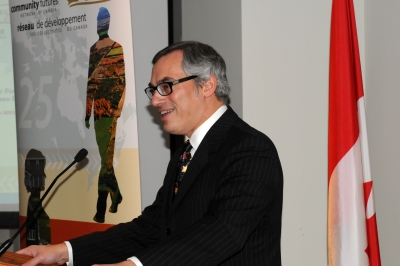December 6, 2011
A government program was praised for its success and celebrated for its longevity on Parliament Hill recently when Members of Parliament and Cabinet Ministers met with members of the Community Futures Network of Canada.
The Community Futures Program was established in 1986 as a means for the federal government to boost Canada’s rural economy. When first announced, the Program was touted as better able to “understand, anticipate and respond to the impact of social and technological change in communities.” The announcement also stated that the Program would address the “pressing needs of communities by becoming involved in initiatives proposed from within the community itself.” Twenty-five years later, and the Community Futures Program has done just that, says David Harris, Chair of the Community Futures Network of Canada.
“Community Futures is the largest, most well-established national community economic development movement in Canada. Community Futures organizations continue to be the driving force for economic growth and renewal by supporting local economic development. They assist in the creation of diverse, competitive local economies in rural communities across Canada,” Harris explains
Community Futures organizations, known as Community Futures Development Corporations or Community Business Development Corporations, are managed by volunteer Boards of Directors. Harris himself is a volunteer, serving on the board in his home Community Futures organization in Nova Scotia. Volunteers live within the community and make decisions based on what is best for their region. Many are successful entrepreneurs who see the benefit of assisting other business people in their area, to promote thriving rural communities. At present, there are about 3,500 volunteers across Canada, guiding the efforts of approximately 1,600 staff members.
With 269 offices covering non-urban areas across Canada, Community Futures organizations offer loans to new and existing small businesses and social enterprises, provide free business information and counselling as well as entrepreneurial training, offer support for community economic development projects, and assist with strategic economic planning.
Since the inception of the program 25 years ago, the Community Futures organizations have assisted 106,000 clients, injected in excess of $3.6 billion into the rural Canadian economy and have helped in the creation of 450,000 jobs. Success stories about thriving small businesses that would not have existed without loans or business counselling from Community Futures offices are plentiful. Many entrepreneurs say that when banks would not take a chance on their business idea, they turned to Community Futures.
In Ontario, Mike Meeker was honoured recently as a 25th Anniversary Entrepreneur. Meeker operates a prosperous fish farm operation on Manitoulin Island, and also sells garden compost made from fish waste. Meeker’s Aquaculture ships about 900,000 pounds of rainbow trout a year, and Meeker’s Magic Mix is a strong spin-off business. “Banks were skeptical about aquaculture,” Meeker says, so 25 years ago he went to the newly opened LaCloche Manitoulin Business Assistance Corporation (LAMBAC), where he received a start-up loan. Across Canada, similar success stories are told.
In fact, to celebrate the 25th Anniversary, the Community Futures Network of Canada collected some stories to create a video. It can be viewed on YouTube at: http://www.youtube.com/watch?v=U1gFqkXiwTY&feature=feedu
